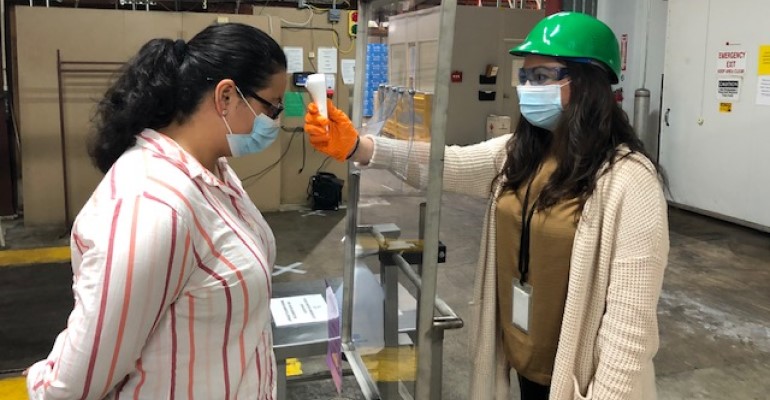CDC issues updated guidelines for meat processors
Criticism still exists that voluntary guidelines will not do enough to protect workers during COVID-19 pandemic.

Multiple outbreaks of COVID-19 among meat and poultry processing facility workers have occurred in the U.S. recently. The Centers for Disease Control & Prevention and the U.S. Department of Labor, in consultation with the U.S. Department of Agriculture, issued interim guidance to help combat the spread of COVID-19 while supporting the continued operation of meat and poultry processing facilities.
Workers involved in meat and poultry processing are not exposed to SARS-CoV-2 -- the virus that causes COVID-19 -- through the meat products they handle. However, their work environments — processing lines and other areas in busy plants where they have close contact with co-workers and supervisors — may contribute substantially to their potential exposures.
Sen. John Hoeven (R., N.D.) has been working with fellow agriculture state senators, including Senate Agriculture Committee chairman Pat Roberts (R., Kan.), John Boozman (R., Ark.) and Thom Tillis (R., N.C.), to ensure the integrity of the food supply chain and keep these facilities safely operating to benefit both producers and consumers.
While speaking to members of the North American Agricultural Journalists on April 27, Hoeven said the focus needs to be on ensuring safeguards are in place, such as protective gear and adequate testing, and also helping plants manage social distancing in order to hopefully remain open or at least shut down for shorter periods of time.
Distinctive factors that affect workers’ risk for exposure to SARS-CoV-2 in meat and poultry processing workplaces are a close distance between workers, that duration of contact, including prolonged closeness between co-workers during long 10- to 12-hour shifts, types of contact and other risks such as sharing transportation and frequent contact with fellow workers in community settings.
The CDC guidelines call for a qualified workplace coordinator to be responsible for COVID-19 assessment and control planning.
The guidelines suggest that companies configure communal work environments so workers are spaced at least 6 ft. apart, if possible. Other suggestions include:
Modify the alignment of workstations, including along processing lines, if feasible, so that workers are at least 6 ft. apart in all directions (e.g., side to side and when facing one another), when possible. Ideally, modify the alignment of workstations so workers do not face one another. Consider using markings and signs to remind workers to maintain their location at their station away from each other and practice social distancing on breaks.
Use physical barriers such as strip curtains, plexiglass or similar materials or other impermeable dividers or partitions to separate meat and poultry processing workers from each other, if feasible.
Consider consulting with a heating, ventilation and air conditioning engineer to ensure adequate ventilation in work areas to help minimize workers’ potential exposures.
Add additional clock-in/out stations, if possible, that are spaced apart to reduce crowding in these areas. Consider alternatives such as touch-free methods or staggering times for workers to clock in and out.
CDC noted that while wearing cloth face coverings is a public health measure intended to reduce the spread of COVID-19 in communities, it may not be practical for workers to wear a single cloth face covering for the full duration of a work shift (e.g., eight or more hours) in a meat or poultry processing facility if they become wet, soiled or otherwise visibly contaminated during the work shift.
Employers may determine that modifying processing or production lines and shifts and staggering workers across shifts would help maintain overall meat and poultry processing capacity while measures to minimize exposure to SARS-CoV-2 are in place. For example, a plant that normally operates on one daytime shift may be able to split workers into two or three shifts throughout a 24-hour period. In meat and poultry processing plants, one shift may need to be reserved for cleaning and sanitization.
CDC also said companies should review leave and incentivize policies -- a common complaint in companies such as Smithfield, which came under fire for its “responsibility bonuses” contributing to workers feeling forced to work to earn the extra bonus.
Screening meat and poultry processing workers for COVID-19 symptoms (such as temperature checks) is an optional strategy employers may use. If implemented for all workers, policies and procedures for screening workers should be developed in consultation with state and local health officials and occupational medicine professionals.
In addition to face shields, workers in meat and poultry processing facilities may need personal protective equipment (PPE) such as gloves, face and eye protection and other types of PPE when cleaning and disinfecting meat and poultry processing plants (including frequently touched surfaces), tools and equipment.
“It’s vital that we keep the food supply chain operating, both for consumers and for our producers, particularly those who raise beef, poultry and pork,” Hoeven said. “We appreciate the Administration for heeding our call to provide flexibility under these guidelines. We will continue working with the Administration and industry to ensure worker safety and maintain consumer access to our nation’s high-quality food supply while we all work together to combat the COVID-19 pandemic.”
The Retail, Wholesale & Department Store Union (RWDSU), which represents thousands of essential and frontline workers across the U.S., criticized multiple industries for their slow response to COVID-19.
Stuart Appelbaum, president of RWDSU, said too many employers have failed to provide necessary PPE, implement social distancing, expand worksite sanitation and other protective measures. The Occupational Safety & Health Administration (OSHA) has not provided any effective response to these requests. Only this past weekend has it even issued guidance for workers in meat processing facilities, Appelbaum said.
“As a result, workers have and will continue to die," he added. "The voluntary guidelines it has issued are insufficient. They have no teeth and employers can, and have, ignored them. These guidelines should be mandatory and enforceable. The agency should issue an Emergency Temporary Standard covering the COVID-19 pandemic, which could actually help workers.”
In a statement, National Cattlemen’s Beef Assn. chief executive officer Colin Woodall welcomed the additional guidance from CDC and OSHA to keep beef plant workers safe.
“This move will also provide state and local governments with the information they need to protect worker safety while continuing to support the operation of beef processing plants. Cattle producers rely on the workers and the plants themselves to ensure a steady supply of beef to consumers and to be certain cattle continue to be able to move through the system,” Woodall said.
“Processing plants are important to cattle producers and consumers, but they also provide an important tax base for rural America and are an important provider of jobs and income in small communities across the nation. The CDC guidelines will help ensure the employees and their communities are better protected from the further spread of COVID-19 while they continue to provide an essential service both to cattle producers and American consumers,” he concluded.
“We appreciate the Administration’s new guidance in an effort to further keep our workers safe and keep food on the shelves,” National Chicken Council (NCC) president Mike Brown said. “The biggest challenge we are experiencing is inconsistencies among state and local health departments and government officials who, in many circumstances, are developing their own criteria for maintaining operations with little or no consideration to previously issued guidance, which adds to confusion and can lead to unnecessary shutdowns. This patchwork approach is posing grave risk to the supply chain and threatening great disruption to NCC member companies. There must be a uniform approach across all states. NCC is urging states to immediately adopt CDC, OSHA and USDA guidelines. When considering human health and food supply issues, time is of the essence.”
About the Author(s)
You May Also Like




